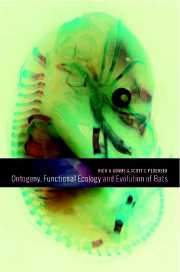Book contents
- Frontmatter
- Contents
- List of contributors
- 1 Integrating ontogeny into ecological and evolutionary investigations
- 2 Bat phylogeny: an evolutionary context for comparative studies
- 3 Early embryology, fetal membranes, and placentation
- 4 Brain ontogeny and ecomorphology in bats
- 5 Evolutionary plasticity and ontogeny of the bat cochlea
- 6 Skull growth and the acoustical axis of the head in bats
- 7 Ontogeny of the chiropteran basicranium, with reference to the Indian false vampire bat, Megaderma lyra
- 8 A theoretical consideration of dental morphology, ontogeny, and evolution in bats
- 9 Wing ontogeny, shifting niche dimensions, and adaptive landscapes
- 10 Ontogeny and evolution of the hindlimb and calcar: assessing phylogenetic trends
- 11 A comparative perspective on the ontogeny of flight muscles in bats
- 12 The ontogeny of behavior in bats: a functional perspective
- Index
4 - Brain ontogeny and ecomorphology in bats
Published online by Cambridge University Press: 17 August 2009
- Frontmatter
- Contents
- List of contributors
- 1 Integrating ontogeny into ecological and evolutionary investigations
- 2 Bat phylogeny: an evolutionary context for comparative studies
- 3 Early embryology, fetal membranes, and placentation
- 4 Brain ontogeny and ecomorphology in bats
- 5 Evolutionary plasticity and ontogeny of the bat cochlea
- 6 Skull growth and the acoustical axis of the head in bats
- 7 Ontogeny of the chiropteran basicranium, with reference to the Indian false vampire bat, Megaderma lyra
- 8 A theoretical consideration of dental morphology, ontogeny, and evolution in bats
- 9 Wing ontogeny, shifting niche dimensions, and adaptive landscapes
- 10 Ontogeny and evolution of the hindlimb and calcar: assessing phylogenetic trends
- 11 A comparative perspective on the ontogeny of flight muscles in bats
- 12 The ontogeny of behavior in bats: a functional perspective
- Index
Summary
INTRODUCTION
From a neuroethological perspective, the spectacular diversity in behavioral ecology among chiropterans is suggestive of a similar richness in brain organization. Dramatic evidence that this is the case is exemplified by the evolution of expanded auditory processing centers subserving echolocation in microchiropterans, specialized visual pathways in some megachiropterans, and novel development of olfactory structures in the Phyllostomidae and Desmodontinae (Henson 1970; McDaniel 1976; Baron et al. 1996c). The overwhelming majority of investigations concerning chiropteran neurobiology have been carried out on adult animals. However, the large number of extant chiropteran taxa represents fruitful ground for studies aimed at understanding the developmental processes underlying mammalian brain evolution. As discussed in this chapter, such data are of great significance with respect to two major issues: bat monophyly and the differential (mosaic) evolution of brain regions in response to co-evolutionary selection pressures.
In this chapter, we first examine chiropteran brains from a regional perspective. We then discuss the role that patterns of neuronal connections have played in discussions concerning bat evolution, with an emphasis on the importance of developmental data to this debate. New data are presented on layer VII of the cerebral cortex, as an example of an adult trait whose variation has specific developmental connotations. Finally, we present a brief account of the relationship of brain traits to behavioral ecology.
CHIROPTERAN BRAIN DEVELOPMENT
The wide range of diversity among chiropteran brains may be appreciated most simply by reference to surface views illustrating the range of development of sulci and fissures in the cerebrum and cerebellum, and the relative sizes of various cranial nerves (Fig. 4.1A–S).
- Type
- Chapter
- Information
- Ontogeny, Functional Ecology, and Evolution of Bats , pp. 93 - 136Publisher: Cambridge University PressPrint publication year: 2000
- 12
- Cited by



